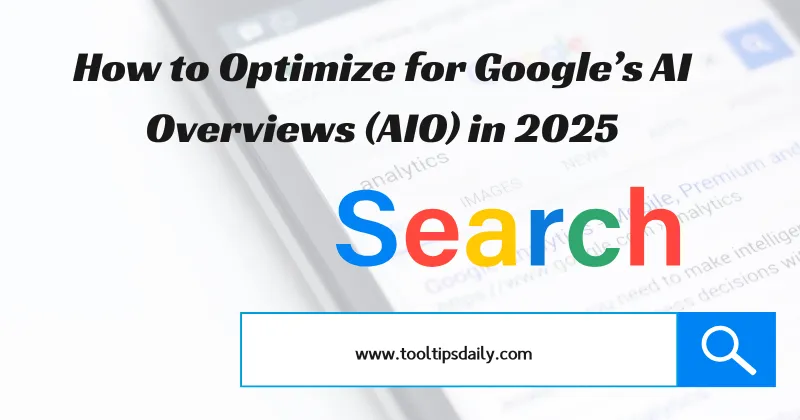In the ever-evolving world of search engines, Google’s AI Overviews (AIO) have emerged as a game-changer, reshaping how users interact with information online. Imagine typing a complex query like “best ways to grow tomatoes in Texas during summer” and getting a concise, AI-generated summary right at the top of the results page, pulling insights from multiple sources. That’s AIO in action—Google’s generative AI feature that synthesizes answers to provide quick, comprehensive overviews. Launched widely in 2024 and expanding globally by 2025, AIO now appears in around 13-50% of searches, depending on the query type and region. For digital marketers, content creators, and businesses, optimizing for Google’s AI Overviews (AIO) isn’t just a nice-to-have; it’s essential for maintaining visibility in a landscape where traditional organic clicks are increasingly competing with AI-driven summaries. In 2025, as AI integration deepens, those who adapt will thrive, driving higher-quality traffic and building brand authority. Let’s dive into how you can position your content to shine in this AI-powered era.
What Are Google’s AI Overviews (AIO)?
Google’s AI Overviews (AIO) are dynamic, AI-generated responses that appear prominently in search results, offering users a synthesized snapshot of information drawn from various web sources. Powered by models like Gemini, AIO goes beyond simple featured snippets by analyzing multiple pages to create contextual, multi-faceted answers. For instance, a search for “how to reduce high blood pressure naturally” might yield a bullet-point list of remedies, complete with citations from sites like Mayo Clinic or Healthline, all without the user needing to click through.
Introduced as part of Google’s Search Generative Experience (SGE) in 2024, AIO has seen rapid evolution. By mid-2025, it’s available in over 200 countries, supporting local languages and handling complex, multi-turn queries through features like AI Mode. Unlike traditional search, which lists blue links, AIO prioritizes user intent, understanding nuances in questions and providing interactive elements, such as replaceable suggestions in travel plans. This shift means AIO isn’t just answering queries—it’s anticipating needs, which is why businesses must optimize for Google’s AI Overviews (AIO) to avoid being overshadowed.
Why AIO Matters for SEO in 2025
In 2025, SEO isn’t solely about ranking in the top 10; it’s about being cited in the AI summary that users see first. Studies show AIO can reduce click-through rates (CTR) for organic results by pushing them down the page, but they also open doors for diverse sites to gain exposure. For example, research from Semrush indicates AIO appears most for informational queries, impacting industries like health, education, and finance hardest. Yet, Google reports that links in AIO often receive more clicks than traditional listings, especially for complex topics, leading to higher-quality traffic.
Failing to optimize for Google’s AI Overviews (AIO) risks traffic drops, but proactive strategies can boost visibility. Brands featured in AIO see increased brand mentions and authority, as users associate them with reliable answers. With AI Overviews now influencing over a billion users, SEO pros must pivot: focus on being a source for AI, not just humans. This means crafting content (How to Identify and Remove Thin Content That Hurts SEO)that feeds Google’s algorithms while satisfying searchers, ensuring long-term relevance in an AI-dominated search ecosystem.
Key Factors Google Considers for AI Overviews
Google’s algorithms for AIO prioritize content that’s helpful, reliable, and aligned with user intent. Core factors include relevance, where content must match query semantics beyond keywords—think long-tail phrases like “how often to water snake plants indoors.” Authority plays a huge role; sites with strong backlinks and domain trust are favored.
Freshness is key in 2025, with updated content outperforming outdated pieces. Google also evaluates structure: pages with clear headings, lists, and summaries are more likely to be parsed. Finally, multimodal understanding means incorporating images, videos, and data that enhance explanations. A practical tip: Use tools like Ahrefs or Semrush to track AIO-triggering keywords, then audit your content for these factors. For example, a gardening blog ranking high for “tomato planting tips” might get cited if it includes step-by-step lists and recent updates on climate changes.
How to Structure Content for AIO Visibility
Structuring content effectively is crucial for optimizing for Google’s AI Overviews (AIO). Start with a TL;DR or summary box at the top, delivering a 50-70 word direct answer to the main query. This mirrors how AIO pulls concise insights. Use H2 and H3 subheadings to break down topics logically, making it easy for AI to extract sections.
Incorporate lists—bulleted or numbered—for steps or tips, as 78% of AIOs feature them per studies. Short paragraphs (3-4 sentences) outperform dense text, and place key answers early. Example: For a query on “best SEO tools in 2025,” lead with a list of top picks like Semrush and Ahrefs, explaining benefits briefly before diving deeper. Add internal links and schema markup to guide AI parsing. Strategy: Revamp existing pages by adding FAQ sections or how-to schemas, boosting chances of inclusion.
How to Resolve the “Page with Redirect” Error in Google Search Console
Role of E-E-A-T (Experience, Expertise, Authoritativeness, Trustworthiness)
E-E-A-T remains a cornerstone for AIO optimization in 2025, as Google favors content demonstrating real-world value. Experience means sharing personal insights—author bios with credentials, like “As a 10-year SEO veteran…” Expertise involves in-depth, accurate info backed by data. Authoritativeness comes from backlinks and citations; aim for links from high-DA sites.
Trustworthiness is built through transparency, such as sourcing claims and avoiding misinformation. Tip: For a health article, include author qualifications, peer-reviewed references, and update dates. Businesses can apply this by creating expert roundups or case studies. Example: A finance site optimized for AIO by adding E-E-A-T signals saw a 20% increase in citations, per industry reports. Regularly audit for E-E-A-T to ensure your content stands out as a reliable source.
Using Conversational & Answer-Focused Content
Conversational content is gold for Google’s AI Overviews (AIO), as it aligns with natural language queries. Write as if answering a friend: Use “you” and questions like “Wondering how to start?” Focus on direct answers, targeting question-based long-tails via tools like Google’s People Also Ask.
Strategy: Employ the CSQAF framework—Citations for sources, Structure for clarity, Quality for depth, Authority via experts, Freshness with updates. Example: For “how to optimize email marketing,” begin with “First, segment your list like this…” in a chatty tone, then expand. This boosts AIO inclusion by making content AI-friendly. Tip: Analyze competitors’ AIO-featured pages and mimic their engaging style while adding unique angles.
Optimizing Technical SEO for AIO
Technical SEO underpins AIO visibility. Ensure fast loading (under 2.5 seconds) with Core Web Vitals compliance. Mobile-friendliness is non-negotiable, as most searches are mobile. Use structured data like FAQPage or HowTo schema to highlight answer blocks.
Crawlability matters: Avoid blocking AI crawlers in robots.txt and use sitemaps. Tip: Implement AMP for quick renders, and monitor with Google Search Console for AIO insights. Example: A SaaS site added schema and improved speed, jumping from no AIO mentions to regular features. In 2025, integrate multimodal elements—alt-texted images and video transcripts—to enrich AI understanding.
Common Mistakes to Avoid in AIO Optimization
Over-optimizing keywords stuffs content unnaturally, repelling AI. Ignoring E-E-A-T leads to low trust scores. Neglecting freshness? Outdated info gets skipped. Poor structure, like walls of text, hinders parsing.
Another pitfall: Focusing only on top rankings without diverse backlinks. Example: A site keyword-stuffed for “AIO tips” but lacked depth, missing citations. Avoid zero-click bait—create value that encourages clicks. Strategy: Audit regularly with tools like SEOmonitor to spot issues early.
Future of AIO and AI-Powered Search
By late 2025, AIO could appear in 50%+ of searches, with deeper integration like voice and visual search. AI Mode will enable conversational flows, demanding adaptive content. Trends: More emphasis on zero-party data and personalized answers.
Businesses should prepare by investing in AI tools for content creation and tracking. Example: Brands using generative AI for outlines stay ahead. The future favors ethical, user-first SEO, where optimizing for Google’s AI Overviews (AIO) means evolving with tech while prioritizing quality.
Conclusion
Optimizing for Google’s AI Overviews (AIO) in 2025 is about blending timeless SEO principles with AI-savvy strategies. By focusing on helpful, structured, and authoritative content, you can secure citations that drive meaningful traffic and build trust. As search becomes more intelligent, those who adapt—through E-E-A-T, conversational writing, and technical tweaks—will lead. Don’t wait; start auditing your site today to thrive in this AI era.
FAQ
How do I know if my content is featured in AIO?
Use tools like Semrush or Ahrefs to track keywords triggering AIO and check for your site’s mentions in summaries or sources.
Is AIO replacing featured snippets?
No, AIO complements them. While AIO handles complex queries with multi-source synthesis, featured snippets still appear for simpler ones, though some predict a phase-out as AIO expands.
What types of queries trigger AIO most often?
Informational queries, especially long-tail questions starting with “how,” “what,” or “best,” in sectors like health, finance, and education.
How can small businesses optimize for AIO without big budgets?
Focus on niche, high-quality content with E-E-A-T signals, use free tools like Google Search Console, and leverage structured data for better visibility.
Does AIO affect global searches equally?
Not yet—AIO is more prevalent in the US and select countries, but 2025 expansions mean optimizing now for international reach is smart.

